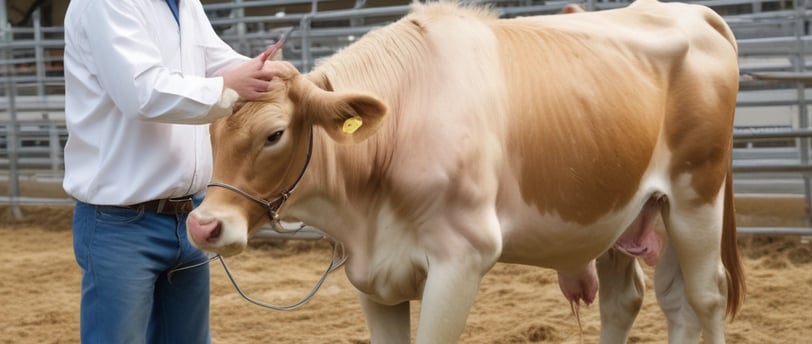Artificial Insemination in Cattle: Pros and Cons for Sustainable Farming
Discover the pros and cons of artificial insemination in cattle, including its impact on cattle breeding techniques, bovine health management, organic farming, and sustainable livestock practices. A complete guide for modern farmers and grass-fed beef producers.
7/12/20254 min read


Artificial Insemination in Cattle: Pros and Cons for Sustainable Farming
Artificial insemination (AI) is a cornerstone of modern cattle breeding techniques. For livestock farmers aiming to improve herd genetics, boost productivity, and embrace more sustainable practices, understanding AI is vital. However, like any method, artificial insemination in cattle comes with both benefits and limitations. This guide breaks down the pros and cons of AI in the context of bovine health management, cattle nutrition, organic cattle farming, and sustainable livestock farming practices.
What Is Artificial Insemination in Cattle?
Artificial insemination involves manually depositing semen from a selected bull into a cow’s reproductive tract. It bypasses natural mating and allows for selective breeding using semen from genetically superior sires, often sourced from different geographic regions.
This method is increasingly favored in both conventional and organic cattle farming systems. AI is particularly useful in improving traits like milk yield, meat quality in grass-fed beef, disease resistance, and calving ease.
Pros of Artificial Insemination in Cattle
1. Genetic Improvement and Selective Breeding
AI allows farmers to access high-quality genetics without the costs of keeping multiple bulls. This leads to:
Improved herd performance in both dairy and beef cattle.
Reduced risk of genetic defects through careful sire selection.
The ability to match specific traits to herd goals, e.g., fertility, longevity, or marbling for grass-fed beef production.
This technique is especially beneficial for organic cattle farming operations seeking to maintain herd integrity while avoiding inbreeding.
2. Enhanced Bovine Health Management
AI reduces the transmission of venereal diseases that are common in natural mating. Healthier cattle mean:
Lower veterinary costs.
Better reproductive outcomes.
Improved overall welfare, aligning with sustainable livestock farming standards.
This aligns with modern bovine health management practices that prioritize long-term animal well-being and preventive care.
3. Cost-Effective and Scalable
Although there are upfront costs for training and equipment, AI:
Reduces the need for keeping dangerous or expensive bulls.
Makes it easier to synchronize breeding and manage calving seasons.
Offers scalability ideal for both small organic cattle farms and large commercial operations.
Over time, AI can lower breeding-related costs while improving herd consistency.
4. Supports Climate-Resilient and Sustainable Farming
Sustainable livestock farming aims to lower carbon footprints, reduce waste, and maximize efficiency. AI supports this by:
Reducing the number of bulls needed on-site.
Minimizing transport emissions by using shipped semen rather than transporting animals.
Encouraging grass-fed beef systems with selectively bred cattle adapted to pasture-based diets.
It’s a strategic fit for future-forward farms.
Cons of Artificial Insemination in Cattle
1. Requires Technical Skills and Infrastructure
To perform AI successfully, farmers must:
Learn to detect estrus (heat) accurately.
Handle semen correctly (liquid nitrogen storage).
Possibly invest in veterinary support or AI technicians.
This technical barrier can be a challenge for small or remote organic farms.
2. Not Always Successful
AI doesn’t guarantee pregnancy. Success rates can be affected by:
Poor cattle nutrition.
Improper timing of insemination.
Reproductive disorders or stress in animals.
This can lead to extended calving intervals and economic losses if not managed carefully.
3. Limited Natural Selection and Adaptation
Over-reliance on select sires could:
Narrow the gene pool.
Reduce herd resilience over generations.
Miss out on naturally adaptive traits valuable in organic cattle farming systems.
Some farmers prefer combining AI with natural selection to maintain genetic diversity.
4. Ethical and Cultural Concerns
In some regions or communities, artificial methods are seen as unnatural. There may be:
Resistance due to cultural beliefs.
Concerns about animal welfare and reproductive manipulation.
These factors need to be considered in outreach and education programs promoting sustainable cattle breeding techniques.
Best Practices for Implementing AI in Cattle Farming
To get the most from AI:
Ensure optimal cattle nutrition. A well-fed cow is more likely to conceive.
Work closely with veterinarians and animal health professionals for bovine health management.
Use AI alongside good pasture management, especially in grass-fed beef systems.
Keep detailed records of breeding, health, and productivity.
Choose sires that align with your farming goals (e.g., disease resistance, growth rate, milk yield).
AI, when thoughtfully implemented, can be a powerful tool in building a sustainable livestock farming system that’s both profitable and responsible.
FAQ: Artificial Insemination in Cattle
1. How is artificial insemination done?
Artificial insemination involves inserting a catheter through the cow’s cervix to deposit semen directly into the uterus. This process must be timed with the cow’s estrus cycle and requires precision to maximize conception rates.
2. Is artificial insemination legal in the UK?
Yes, artificial insemination is fully legal and widely used in the UK. However, only trained and certified professionals or farmers may perform the procedure to comply with animal welfare regulations.
3. How much does it cost to get pregnant with AI?
The cost varies but typically includes semen ($10–$50 per dose), technician fees, synchronization drugs, and handling equipment. On average, expect to spend $40–$100 per cow per cycle, depending on region and service quality.
4. What are the 4 types of artificial insemination?
The four main types of AI include:
Intracervical Insemination (ICI)
Intrauterine Insemination (IUI)
Intratubal Insemination (ITI)
Intravaginal Insemination (IVI)
In cattle, intrauterine insemination is most common and effective when timed correctly.
Conclusion: Is AI the Future of Cattle Breeding?
Artificial insemination offers transformative benefits for cattle breeding techniques, especially in systems focused on grass-fed beef, organic cattle farming, and sustainable livestock practices. While it requires investment in training and herd management, the payoff in terms of genetics, health, and efficiency can be substantial.
The key is to integrate AI into a broader farm strategy that prioritizes animal welfare, regenerative practices, and farmer education. Used wisely, it’s not just a modern convenience it’s a powerful step toward a more resilient, ethical, and productive livestock future.
